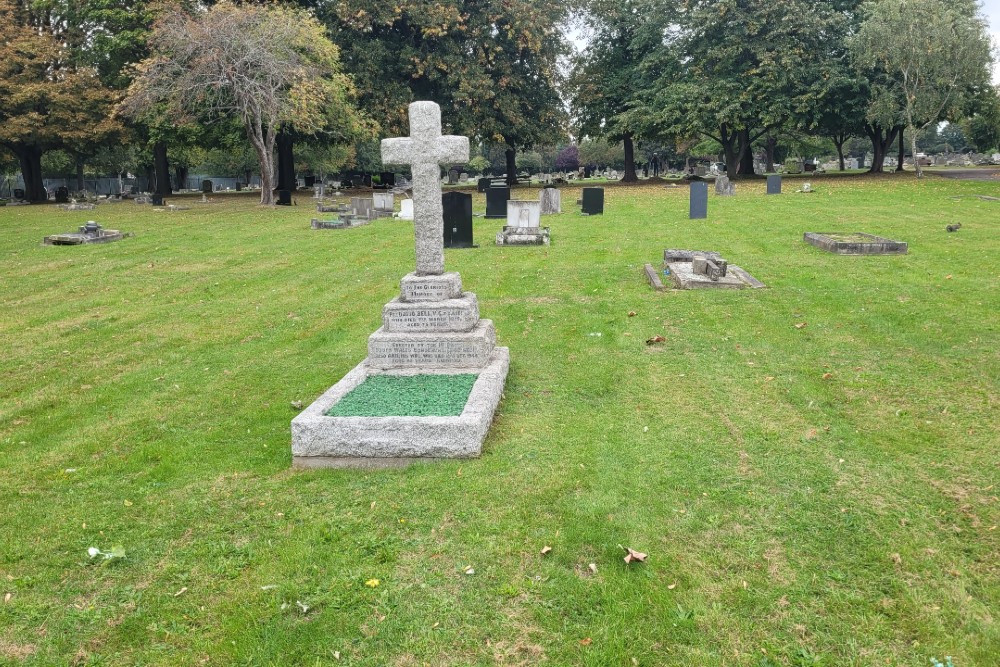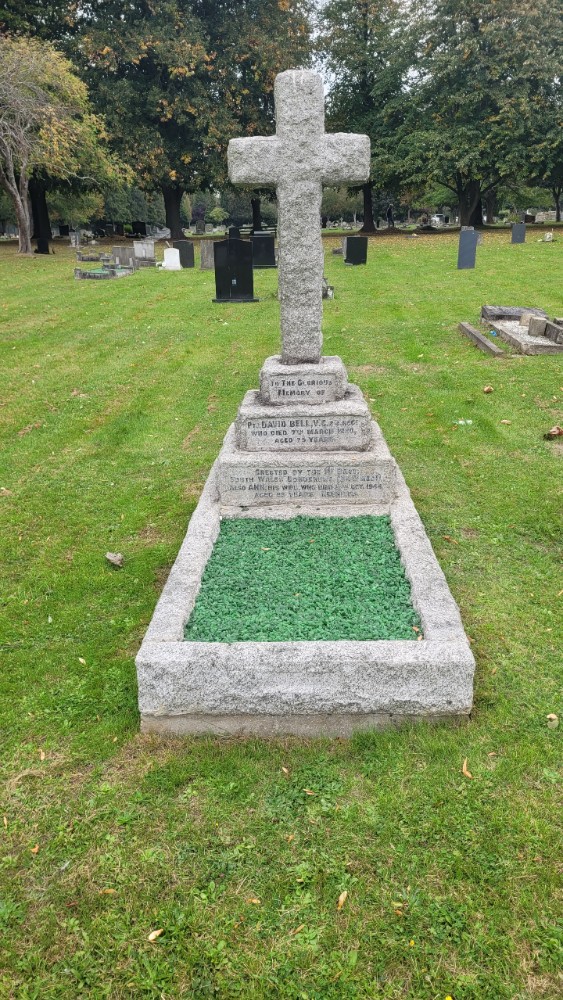Graves of VC Recipients Gillingham
There are 3 graves of Victoria Cross recipients in Gillingham's Woodland Cemetery. (only Private Bell and Lt Cdr Esmonde are pictured)
David Bell VC
b. 1845 County Down, Ireland. d. 07/03/1920 Gillingham, Kent.
David Bell (1845-1920) was born in 1845 in County Down, Ireland and enlisted with the 24th Regiment of Foot (later South Wales Borderers) and was serving in the 2nd Battalion when he was posted with his Regiment to India.
Shortly before the 7th May 1867, at the island of Little Andaman, in the Bay of Bengal, a ship called the “Assam Valley” had anchored, and some of the crew went ashore. Shortly afterwards, news came that the crew had been set upon and murdered by some of the natives, as none of them had returned. In order to ascertain the crew’s fate, a second steamer was sent from Rangoon and landed near the island on the 7th. Some of their crew was attacked by the natives and with a huge storm raging, a rescue mission was organised to try and reach them. With the soldiers in peril on shore, Dr Campbell Mellis Douglas and four fellow members of the 24th including David Bell, manned a gig and attempted to reach them.
They very nearly succeeded in their endeavours, but, the boat beginning to fill rapidly, they were forced to retire. They then made a second attempt and were successful in reaching the shore, taking off five men. On these being placed safely on board, the doctor and his four brave men turned once more to the rescue of the rest of the soldiers, and by their strenuous efforts the entire party was eventually taken off the island.
Bell alongside his four comrades, was gazetted for the VC on 17th December 1867, and was invested with his medal in Rangoon on 16th April 1868 by Major-General A Faunce, the GOC Pegu. Little is known of his career following the incident in the Andaman Islands, and he eventually retired and settled in Kent. He died on 7th March 1920 aged 75 at his home, 2 Unity Cottages, Gardiner Street, Gillingham. He was laid to rest at Woodlands Cemetery, Gillingham. His medals are held by the South Wales Borderers Museum, Brecon.
LOCATION OF MEDAL: SOUTH WALES BORDERERS MUSEUM, BRECON, WALES.
BURIAL PLACE: WOODLANDS CEMETERY, GILLINGHAM, KENT. SECTION CH GRAVE 782
-------------------------------
Claude Congreve Dobson
b. 01/01/1885 Barton, Gloucestershire. d. 26/06/1940 Chatham, Kent.
Claude Congreve Dobson (1885-1940) was born on 1st January 1885 in Barton Regis, Somerset, the son of Nelson Congreve Dobson, who hailed from Holbeach, Lincolnshire, and Louisa Alice Pierce, who hailed from Bristol. By 1901, Claude was a naval cadet based at Dartmouth. Dobson was promoted to the rank of Lieutenant on 30th March, 1906. After appointments in Niobe, Vengeance and Illustrious, he was appointed to Mercury on 12th January, 1907 for instruction in submarines.
Dobson was admitted to Plymouth Hospital on 19th August,1909 to be treated for syphilis, being discharged on 17th September. In 1911, Dobson was informed that he was to blame for a collision between B 5 and the Lily of Devon. He received the customary mild rebuke that he was to “be more careful in future.” He was appointed to Monarch on 27th March, 1912.
Dobson was promoted to the rank of Lieutenant-Commander on 30th March, 1914. Dobson was appointed in command of the submarine C 27 on 7th April, 1914. On 20th July, 1915, C 27 sank U 23 off Fair Island. Dobson was awarded the D.S.O. for this success, being decorated by the King on 14th October, 1915 at Buckingham Palace.
Dobson was promoted to the rank of Commander on 30th June, 1918 and was superseded in command of the K 10 on 15th August, having been hospitalised two days previously, suffering from neurasthenia. Given four weeks to recover, he was still unfit when discharged on 19th September, but on 10th October was deemed fit for shore service.
Dobson was appointed to Osea on 17th July, 1919 to command a flotilla of Coastal Motor Boats, and was awarded the Victoria Cross “for most conspicuous gallantry” when on 18th August, 1919 his C.M.B. 31BD was credited with scoring two torpedo hits on a Russian battleship in Kronstadt harbour during a raid that Dobson was commanding. Dobson was re-appointed to Osea for command of a C.M.B. flotilla on 18th December, 1919. His work with these small vessels would take him have to Haslar C.M.B. Base for command of a flotilla on 19th April, 1921. He was superseded on 15th December, 1921.
On 19th Octoberr 1920, he married Edith Archibald MacMechan at Emanuel Church, Clifton, Bristol. In 1921, she gave birth to twins. Dobson was loaned to the R.A.N. on 20th January, 1922, coming back on 9th January, 1925 for an appointment to Victory, additional for U.T. (unpaid time) no in excess of six months while he battled health and vision problems that rendered him fit for harbour but not sea duty. On 3rd March, he was appointed to Centurion, being promoted to Captain on 31st December, 1925 and being superseded on 5th January, 1926.
Dobson was appointed in command of the light cruiser Colombo in October, 1927. In October, 1931, he was appointed in command of the light cruiser Cambrian. Dobson was placed on the Retired List at his own request on 1st January, 1935 and promoted to the rank of Rear-Admiral on the Retired List on 19th July, 1936.
Claude Dobson died on 26th June 1940 in the Royal Naval Hospital in Chatham, Kent. He was buried in Woodlands Cemetery, Gillingham, Kent. His medals including the VC, DSO, 1914-15 Star, British War Medal 1914-20, Victory Medal 1914-19 with Mentioned in Despatches oakleaf, and King George VI Coronation Medal 1937 are held by the National Maritime Museum, Greenwich.
LOCATION OF MEDAL: NATIONAL MARITIME MUSEUM, GREENWICH, LONDON.
BURIAL PLACE: WOODLANDS CEMETERY, GILLINGHAM, KENT.
----------------------------
Eugene Kingsmill Esmonde VC DSO
b. 01/03/1909 Thurgoland, Yorkshire. d. 12/02/1942 English Channel
Eugene Kingsmill Esmonde (1909-1942) was born on 1st March 1909 in Thurgoland, near Barnsley, Yorkshire where his father Dr John Joseph Esmonde (1862–1915) was in temporary General Practice. Though by birth English, his parents were from Ireland and he returned to his family’s ancestral home of the Esmonde Baronets in Drominagh, North Tipperary as a boy and was educated by the Jesuits, first at Wimbledon College in London and then at Clongowes Wood College in co. Kildare, Ireland.
He had three elder half-brothers from his father’s first marriage, Sir John Esmonde, 14th Baronet, who served in the First World War, 2nd Lt. Geoffrey Esmonde (1897–1916) who was killed in action in the First World War serving with the 26th Tyneside Irish Battalion of the Northumberland Fusiliers, and Sir Anthony Esmonde, 15th Baronet.
He was commissioned into the Royal Air Force as a Pilot Officer on 28th Deceember 1928. He became a flying instructor in 1932 and then left the Service in 1934, whereupon he joined both the Reserve and Imperial Airways, where he trained as a flying boat pilot. In January 1939 he received a letter from the Admiralty offering him a commission in the newly formed Royal Naval Air Branch. He asked to be released from the Reserve and reported to RNAS Lee-on-Solent for refresher training and was appointed to 754 Naval Air Squadron (NAS).
In May 1940 he took command of 825 NAS on board HMS FURIOUS. Esmonde led attacks on Trondheim and Tromso, before receiving orders to embark on board HMS VICTORIOUS. She was destined for the Mediterranean but, following the sinking of the battleship HMS HOOD, was diverted to help the search for the German battleship BISMARCK. Esmonde led his Squadron in an attack against BISMARCK on the night of 24th May 1941, after which he was awarded the DSO. His Squadron was then transferred to HMS ARK ROYAL, where he operated until she was torpedoed in November 1941. He was one of the last to leave the ship before she sank.
In late 1941/early 1942 British Naval Intelligence had received reports that the German Battle Cruisers SCHARNHORST and GNEISENAU, and the Cruiser PRINZ EUGEN, were planning to attempt a high speed transit up the heavily defended English Channel from Brest to Hamburg. This presented the Home Fleet with a good opportunity to attack these very dangerous ships, and a large number of aircraft and vessels were amassed in ports and aerodromes along the south coast in late 1941. The six Swordfish of 825 NAS were among the units assigned to Operation Fuller.
Probably through good intelligence of their own, the German Navy waited before attempting what would become known as the Channel Dash, and gradually the British assets grouped along the English coast were re-tasked to higher priority requirements. By February 1942 the only remnants of this defensive fleet were the six Swordfish of 825 NAS based at Manston in Kent, armed with one torpedo each. The German Navy took their opportunity.
On the morning of 12th February 1942, Lieutenant-Commander Esmonde, in command of 825 NAS of the Fleet Air Arm, was told that SCHARNHORST, GNEISENAU and PRINZ EUGEN, strongly escorted by some thirty surface craft and fighter cover, were entering the Straits of Dover, and that his Squadron must attack before they reached the sand-banks North East of Calais. This was esmonde 2the day after Esmonde had been awarded the DSO at Buckingham Palace from the King for the BISMARCK action.
Esmonde knew well that his enterprise was desperate. Soon after noon he and his Squadron of six Swordfish set course for the Enemy, and after ten minutes’ flight were attacked by a strong force of enemy fighters. They had been briefed to rendezvous with three RAF Fighter squadrons, but due to a variety of circumstances, only ten Spitfires arrived. Contact was soon lost with his fighter escort and in the action which followed all his aircraft were damaged. He flew on, cool and resolute, serenely challenging hopeless odds, to encounter the deadly fire of the Battle-Cruisers and their Escort, which shattered the port wing of his aircraft. Undeterred, he led his Squadron on, straight through this inferno of fire, in steady flight towards their target. Almost at once he was shot down, but his Squadron went on to launch a gallant attack, in which at least one torpedo is believed to have struck the German Battle-Cruisers. All six Swordfish were lost and only five of the eighteen crewmen survived. Esmonde was posthumously awarded the Victoria Cross.
Five survivors were fished out of the Channel waters and only one of these men was unwounded. Four of them were awarded the DSO, the other the CGM. About seven weeks later Eugene Esmonde’s body, still in his lifejacket, was washed ashore in the Thames Estuary near the River Medway. Esmonde was buried at Woodlands Cemetery, Gillingham, Kent, on the 30th April 1942.
Esmonde’s medals including the VC, DSO, 1939-45 Star, Atlantic Star and War Medal 1939-45 with Mentioned in Despatches oakleaf were held within the family until November 2007 when they were placed on loan with the Imperial War Museum, London, where they form part of the Ashcroft Gallery’s collection.
LOCATION OF MEDAL: LORD ASHCROFT GALLERY, IMPERIAL WAR MUSEUM.
BURIAL PLACE: WOODLANDS CEMETERY, GILLINGHAM, KENT.
SECTION A, RC PLOT, GRAVE 187
Do you have more information about this location? Inform us!
Source
- Text: Victoria Cross on Line
- Photos: Anthony (Sharky) Ward
Nearby
Museum
- Royal Engineers Museum and Library - Gillingham
- Fort Amherst - Gillingham
- Historic Dockyard Chatham - Chatham
Point of interest
- Air-Raid Shelter Brompton - Brompton
- Air-Raid Shelter Restoration House - Rochester
- Soviet Foxtrot Class Submarine - Rochester
Monument
- Memorial Chatham 'Drill Shed' Air Raid 3 September 1917 - Gillingham
- Memorial HMS Bulwark and HMS Princess Irene - Gillingham
- Memorial HMS Glatton - Gillingham
Cemetery
- Dutch War Graves Woodland Cemetery Gillingham - Gillingham
- Commonwealth War Graves Woodlands Cemetery - Gillingham
- Chatham Naval Memorial - Chatham






